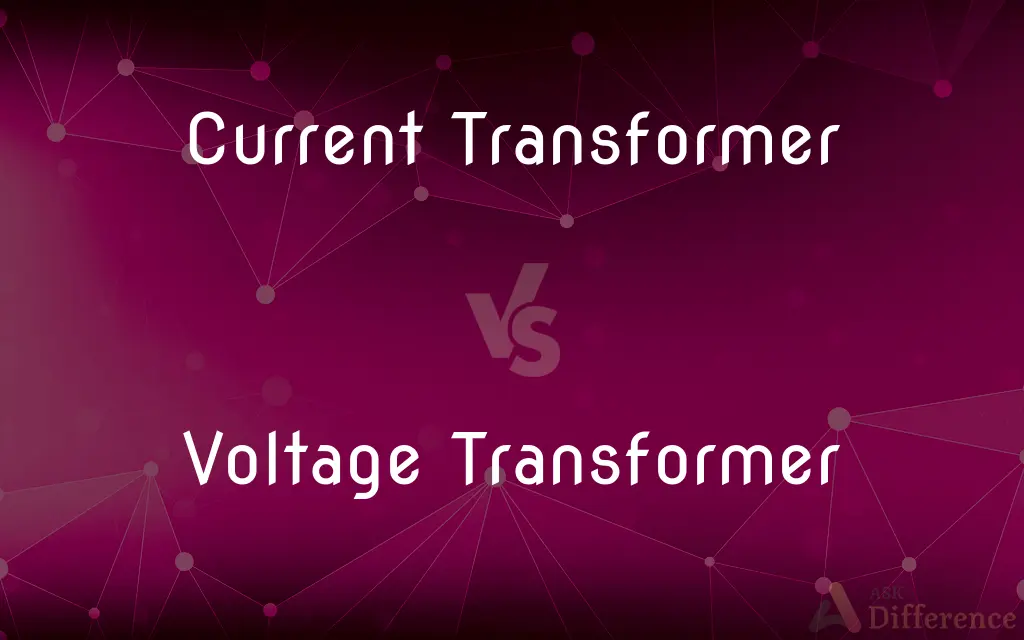Current Transformer vs. Voltage Transformer — What's the Difference?
Edited by Tayyaba Rehman — By Urooj Arif — Published on August 27, 2024
Current transformers (CTs) measure high currents in power systems by producing a reduced, safe current for monitoring, while voltage transformers (VTs) step down high voltages to a lower, measurable level for accurate monitoring and metering.

Difference Between Current Transformer and Voltage Transformer
Table of Contents
ADVERTISEMENT
Key Differences
Current transformers are designed to provide a scaled-down current proportional to the current flowing through a power system, making it easier and safer to measure high currents indirectly. Voltage transformers, on the other hand, reduce high system voltages to a lower standard value, enabling the safe and precise measurement of electrical voltage in power systems.
CTs are critical in protection systems, where they supply current to protective relays and meters, ensuring that these devices are isolated from high-voltage conditions. VTs are essential for providing voltage inputs to metering systems, protective relays, and control panels, maintaining accuracy and safety in high-voltage environments.
The operation of a current transformer involves creating a secondary current that is accurately proportional to the primary current, but at a lower, standardized level. Voltage transformers operate by applying the principle of electromagnetic induction to reduce the primary high voltage to a secondary, standardized lower voltage, maintaining the proportionality between the two.
CTs are often rated in terms of their primary and secondary currents, such as 1000:5, indicating that a 1000 A primary current results in a 5 A secondary current. VTs are rated based on their voltage reduction capability, such as 11000:110, signifying that a 11 kV primary voltage is transformed to a 110 V secondary voltage.
In terms of application, CTs are predominantly used in current measuring and protective relay schemes in electrical power systems, while VTs are utilized for voltage measurement, metering, and protection in substations and electrical power distribution.
ADVERTISEMENT
Comparison Chart
Function
Reduces high currents to a lower, manageable level for measurement.
Steps down high voltages to a lower level for safe measurement.
Primary Use
Current measurement and protection in power systems.
Voltage measurement, metering, and protection.
Operation Principle
Proportional reduction of current through electromagnetic induction.
Voltage reduction through electromagnetic induction, maintaining voltage proportionality.
Rating Example
1000:5 (1000 A primary to 5 A secondary)
11000:110 (11 kV primary to 110 V secondary)
Safety Feature
Provides isolation from the high-voltage power system, enhancing safety for personnel and equipment.
Offers precise voltage measurement and isolation from high-voltage systems, ensuring safety.
Compare with Definitions
Current Transformer
A device that converts high currents to a lower, measurable current.
A CT with a 1000:5 ratio is used to monitor the current in a high-power electrical circuit.
Voltage Transformer
Ensures accurate voltage readings in power distribution systems.
VTs provide precise voltage inputs for protective relay systems.
Current Transformer
Provides electrical isolation between high-power circuits and measuring instruments.
CTs ensure the safety of metering equipment by providing electrical isolation.
Voltage Transformer
Rated based on their voltage reduction capability.
A VT with a 22000:110 ratio accurately steps down 22 kV to 110 V.
Current Transformer
Used for accurate current measurement in electrical systems.
Engineers installed CTs for precise current monitoring in the substation.
Voltage Transformer
Steps down high voltage to a lower, standard value for measurement.
A VT is used to reduce the 11 kV line voltage to 110 V for metering.
Current Transformer
Rated by their primary to secondary current ratio.
A CT rated at 500:5 allows safe measurement of up to 500 A primary current.
Voltage Transformer
Offers voltage isolation to protect metering equipment.
VTs isolate the high-voltage supply from sensitive measuring instruments.
Current Transformer
Integral to protective relays in electrical protection schemes.
CTs supply current to protective relays for fault detection in power grids.
Voltage Transformer
Used in both metering and protection circuits.
VTs are installed in substations for both metering and protection purposes.
Common Curiosities
Can VTs be used for both metering and protection?
Yes, VTs are used for accurate voltage measurements in metering applications and provide voltage inputs for protective relays, serving both purposes in power systems.
How do CTs ensure safety in electrical systems?
CTs provide isolation from high-voltage circuits, reducing the current to a safe level for measurement and monitoring, thus protecting equipment and personnel.
Why are VTs important in high-voltage systems?
VTs step down high voltages to manageable levels for accurate measurement and monitoring, ensuring safety and precision in high-voltage electrical systems.
How is the accuracy of CTs and VTs maintained?
Regular calibration and maintenance are essential to ensure the accuracy of CTs and VTs, along with proper installation and operation within their rated capacities.
Can CTs and VTs be used together?
Yes, CTs and VTs are often used together in electrical systems for comprehensive monitoring and protection, measuring both current and voltage accurately.
Are there any special considerations for CT and VT selection in renewable energy systems?
In renewable energy systems, considerations include the range of operating conditions, compatibility with power electronics, and the need for accuracy in monitoring and protection schemes.
How do environmental conditions affect CT and VT performance?
Extreme temperatures, humidity, and corrosive environments can impact the insulation and overall performance of CTs and VTs, necessitating suitable designs and protective measures.
What happens if a CT is operated without a load?
Operating a CT without a connected secondary load (burden) can lead to dangerously high voltages, potentially damaging the CT and posing a safety risk.
What are the consequences of incorrect CT or VT installation?
Incorrect installation can lead to inaccurate measurements, safety hazards, and potential damage to the system and devices connected to it.
What is the significance of the turns ratio in CTs and VTs?
The turns ratio determines the level of current or voltage reduction, directly affecting the accuracy and functionality of CTs and VTs in their respective applications.
Share Your Discovery

Previous Comparison
Hyaluronic Acid vs. Niacinamide
Next Comparison
Diamond Art vs. Diamond PaintingAuthor Spotlight
Written by
Urooj ArifUrooj is a skilled content writer at Ask Difference, known for her exceptional ability to simplify complex topics into engaging and informative content. With a passion for research and a flair for clear, concise writing, she consistently delivers articles that resonate with our diverse audience.
Edited by
Tayyaba RehmanTayyaba Rehman is a distinguished writer, currently serving as a primary contributor to askdifference.com. As a researcher in semantics and etymology, Tayyaba's passion for the complexity of languages and their distinctions has found a perfect home on the platform. Tayyaba delves into the intricacies of language, distinguishing between commonly confused words and phrases, thereby providing clarity for readers worldwide.













































